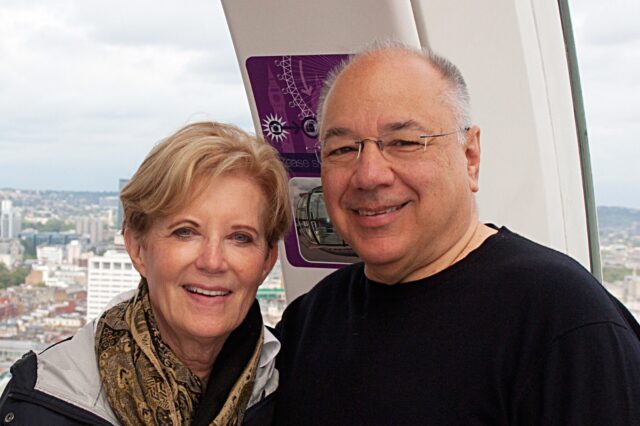Walking with confidence
UF Health experts treat a patient diagnosed with a rare neurological condition.

Mary Lou Preski with her husband, Don.
Mary Lou Preski was diagnosed with a rare condition called normal pressure hydrocephalus, or NPH, the year she turned 76. NPH is a condition in which there is an excessive volume of cerebrospinal fluid in the brain, dilating the ventricular system, which then causes pressure on some of the vital nerve pathways. She faced a future of continued limited mobility, loss of muscle control and a progressive decline in memory.
With early diagnosis and treatment, patients with NPH may improve significantly. A team of physical therapists, neuroradiologists, neurologists and neurosurgeons work together to slow the disease progression and restore as much body control and mobility as possible.
Preski underwent shunt surgery in May 2021 at UF Health Jacksonville to help treat her NPH. A catheter diverted the spinal fluid in her brain down to the abdomen. Diverting extra fluid from her brain allowed her to regain an active lifestyle after suffering severe symptoms for several years.
“If you had known me before the surgery, you wouldn’t believe I’m the same person. My friends can’t believe it,” Preski said.
Diagnosis and treatment
For 15 years, Preski’s local primary care provider in Tampa treated her for chronic inflammatory demyelinating polyradiculoneuropathy, or CIDP, a disorder that involves nerve inflammation and can lead to a loss of muscle control. As Preski’s symptoms worsened, including difficulty walking and bladder leakage, she sought a second opinion.
Preski’s husband, Don, found Alan Berger, MD, a neurologist at UF Health Jacksonville who specializes in neuromuscular conditions. After the initial consult and start of treatment, Berger believed Preski’s difficulty walking was not consistent with CIDP, and instead pointed toward Parkinson’s disease. Berger had Preski meet with fellow UF Health Jacksonville neurologist Natalya Shneyder, MD, a movement disorder specialist.
Shneyder began treating Preski in April 2020 with a medication in trial for Parkinson’s disease. The medication helped for several months, but not as much as expected. Shneyder ordered a DaTscan, a test used to confirm the diagnosis of Parkinson’s disease in unclear cases. The scan returned normal, meaning there was a low possibility of Parkinson’s disease. Shneyder then turned to the possibility of NPH, a rare condition that can mimic other disorders, such as Parkinson’s disease.
Shneyder says people who move slower and have difficulty getting up may sometimes accept it as a sign of aging. Once the condition worsens, patients usually end up needing a walker or wheelchair.
“Normal pressure hydrocephalus is usually a condition of older adults, age 65 and older,” Shneyder said. “I would encourage people who are having progressive problems with their mobility to get an evaluation from a neurologist. A timely evaluation is essential, as there is a point in this condition where surgery cannot improve prognosis.”
Successful shunt surgery
Preski underwent a spinal tap, where a small sample of cerebrospinal fluid is removed and the patient is assessed by physical therapy to see if symptoms improve temporarily. Preski responded well to the spinal tap and was deemed a good candidate for shunt surgery.
Shneyder referred Preski to Dunbar Alcindor, MD, a neurosurgeon with UF Health Jacksonville, who specializes in functional and stereotactic neurosurgery.
“In Mrs. Preski’s case, the fluid within the ventricles was compressing different parts of the brain that were helping to control her bladder function and ability to walk,” Alcindor said. “By diverting that fluid with a shunt, it relieved pressure on those areas and improved symptoms.”
Katherine Singh, APRN, a nurse practitioner with UF Health Jacksonville, performed the initial evaluation and imaging for Preski. About six weeks after the surgery, Singh conducted a virtual visit with Preski.
“She was so thankful that she could walk again,” Singh said. “What matters most to me is seeing a patient have such an improvement in quality of life, even at 76 years old. I saw her in person in December, and she’s back to doing her normal activities.”
Life after surgery
Preski worked with physical therapists after surgery until she was walking normally and no longer considered a fall risk.
“It’s like a miracle. I’m walking normal. The shaking in my hands has stopped a lot, and I can control my bladder all day,” Preski said. “I was so impressed with the care from the hospital and staff. I’ll never go anyplace else.”
About the author
